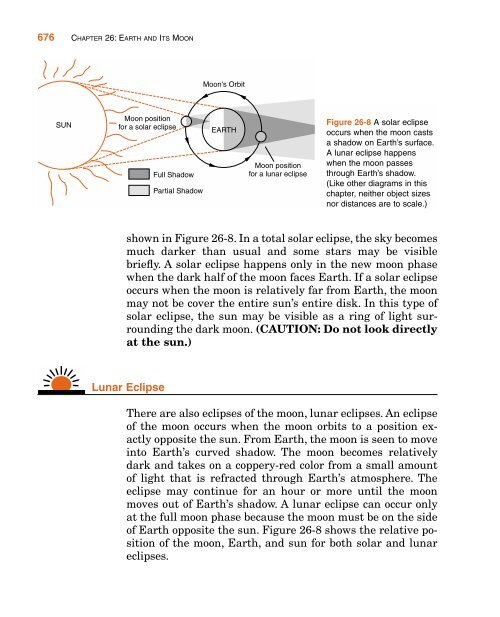Chapter 26 Earth and Its Moon
Chapter 26 Earth and Its Moon
Chapter 26 Earth and Its Moon
You also want an ePaper? Increase the reach of your titles
YUMPU automatically turns print PDFs into web optimized ePapers that Google loves.
676 CHAPTER <strong>26</strong>: EARTH AND ITS MOON<br />
SUN<br />
<strong>Moon</strong> position<br />
for a solar eclipse<br />
shown in Figure <strong>26</strong>-8. In a total solar eclipse, the sky becomes<br />
much darker than usual <strong>and</strong> some stars may be visible<br />
briefly. A solar eclipse happens only in the new moon phase<br />
when the dark half of the moon faces <strong>Earth</strong>. If a solar eclipse<br />
occurs when the moon is relatively far from <strong>Earth</strong>, the moon<br />
may not be cover the entire sun’s entire disk. In this type of<br />
solar eclipse, the sun may be visible as a ring of light surrounding<br />
the dark moon. (CAUTION: Do not look directly<br />
at the sun.)<br />
Lunar Eclipse<br />
Full Shadow<br />
Partial Shadow<br />
<strong>Moon</strong>'s Orbit<br />
EARTH<br />
<strong>Moon</strong> position<br />
for a lunar eclipse<br />
Figure <strong>26</strong>-8 A solar eclipse<br />
occurs when the moon casts<br />
a shadow on <strong>Earth</strong>’s surface.<br />
A lunar eclipse happens<br />
when the moon passes<br />
through <strong>Earth</strong>’s shadow.<br />
(Like other diagrams in this<br />
chapter, neither object sizes<br />
nor distances are to scale.)<br />
There are also eclipses of the moon, lunar eclipses. An eclipse<br />
of the moon occurs when the moon orbits to a position exactly<br />
opposite the sun. From <strong>Earth</strong>, the moon is seen to move<br />
into <strong>Earth</strong>’s curved shadow. The moon becomes relatively<br />
dark <strong>and</strong> takes on a coppery-red color from a small amount<br />
of light that is refracted through <strong>Earth</strong>’s atmosphere. The<br />
eclipse may continue for an hour or more until the moon<br />
moves out of <strong>Earth</strong>’s shadow. A lunar eclipse can occur only<br />
at the full moon phase because the moon must be on the side<br />
of <strong>Earth</strong> opposite the sun. Figure <strong>26</strong>-8 shows the relative position<br />
of the moon, <strong>Earth</strong>, <strong>and</strong> sun for both solar <strong>and</strong> lunar<br />
eclipses.

















